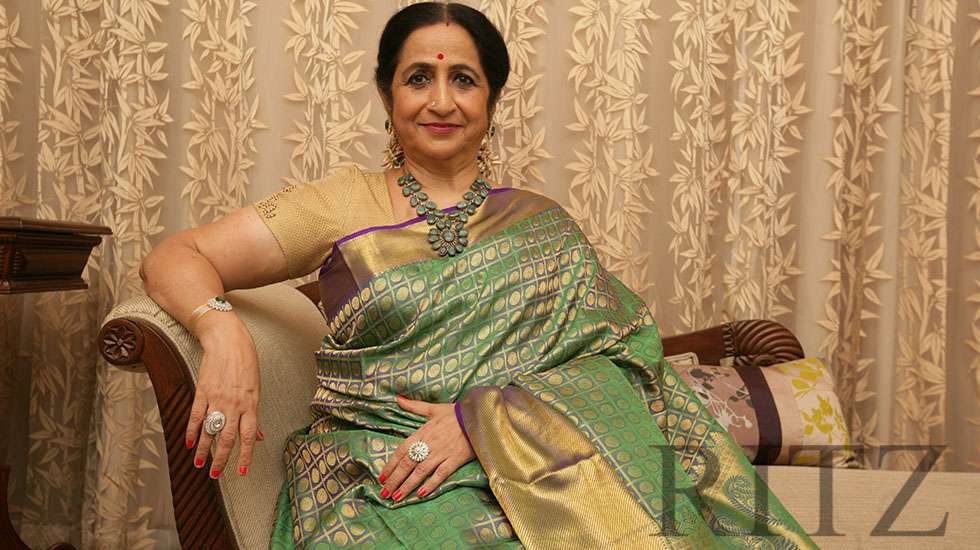It is the Margazhi season and music is predictably in the air. While the city limps back to some semblance of normalcy after Vardah, happier moments are being experienced in the sabhas and other forums where music is being made, dances are being discussed, a variety of tiffins are being eaten, several cups of piping hot filter coffees are being dispensed and rustling silks are being displayed on concert platforms.
Chitra Mahesh talks to Aruna Sairam, one of the biggest singers in the Carnatic firmament today on how she has infused her stage appearances with a dose of style and chutzpah, that is inimitably her own.
Artists and rasikas are both making style statements – whether it is discussed or not there is a certain dress code that has been around for years and this really is the time to go traditional and sport all those pieces one would not normally take out. The jhumkas are back and how! Kancheepuram silk saris and half saris are draped neatly around mostly slim bodies; eyes are lined enticingly with kohl and blouses are getting more and more resplendent, sometimes even jazzily so.
Aruna Sairam who is at this moment having a great musical season, is one of the most vibrantly dressed artists on stage. Her saris are always silks, while the trademark diamonds on her ears and neck, a big red bindi which enhances her kajal-lined eyes and her stately posture on the concert platform immediately evoke a sense of eager anticipation about how the concert will evolve.
‘’How I am dressed for a concert,’’ she says, “is very important. I think this is true of all artists today. It is an important part of the experience for the audience in the way artists come and take the seats – the aura they exude before the music is a big part of it all.’’
How do you do this and what made you decide that this is the persona you would evolve into?
“Every year I choose the saris for the concerts. While others shop during festivals like Deepavali or Pongal, I shop only for the season. When I go looking around I feel intuitively what would look nice for which stage. Because each space has its own vibe. For instance, for Music Academy I would like to go for the traditional classical colours – old colours that have been in use for many years. I always choose koothuvangina border – contrast borders etc. and wear my diamond earrings. For a place like Kamarajar Arangam, which is a huge auditorium, I would probably choose more lustrous, colourful saris with large, jari borders – glamorous in a way and go bold on the accessories with chunky pieces that are very visible. Also because so many of our performances are televised, one has to wear stuff that is photogenic. I also make sure that I ask the producer about the backgrounds chosen so that colours do not clash.”
Do you feel that your music needs this kind of a presentation? That you need to dress in a particular kind of a way? To make a kind of a mark or a style statement? When did this come about?
“I don’t know when this came about but I do know that even while I was growing up, I have keenly watched artists and how they appeared. My own guru, Brindama had her own style just like her music. It was understated, deep and quite sombre. Not for example like that of ML Vasanthakumari whose music was brilliantly bright. So therefore my guru’s garments reflected her nature. She wore the deep-sea kind of colours – dark, with mild veldhari or rudraksham and just big diamond earrings, which were probably so heavy that they swung whenever she moved or sang. In fact her musical character shone through her choice of colours and demeanor. And then there was MS Amma, who owned her style so powerfully that colours were even named after her! While she was never over dressed, there was glamour in the way she presented herself. The curl of her hair, the diamond nose stud with other coloured gems, the glass bangles in between gold ones, bright green sari with brilliant blue borders… I have never seen her shabbily dressed. I would go so far as to say that for an artist simply sitting at home also means to be in elegant understated clothes, and that is a good thing. It speaks of that extra five minutes you take to groom yourself.’’
Does the way you dress take away from the music?
“No, not at all. When I start putting on my makeup, I get into the mood of the concert. Kathakali artists as you know have long hours of getting ready for a performance. It takes two hours for the layers itself. And I am told and I have observed them – that those hours are spent meditating and getting into the mood and preparing for that role they are going to play. In the same way, when I wear my jewellery and my sari I am getting into the mood of the concert.”
Was it always like this?
“Perhaps not. But at some point once I came into my own as a professional artist – you know when you have arrived, there is a lot of emphasis on how you appear on stage. You do focus a lot on that. Earlier I was very casual – I didn’t know how to put on makeup, I would appear in a casual sari, concerts too took it as it came.”
“And then there was MS Amma, who owned her style so powerfully that colours were even named after her! While she was never over dressed, there was glamour in the way she presented herself. The curl of her hair, the diamond nose stud with other coloured gems, the glass bangles in between gold ones, bright green sari with brilliant blue borders… I have never seen her shabbily dressed”
Today it is a conscious attempt and decision about how to appear before an audience. It’s also part of the image?
‘’I guess so and it is not just the female artists who are part of this. Male artists are also very conscious about their appearance. Today you see such good kurtas and accessories. Earlier the angavastrams would be simple – but now they are style statements in themselves. In fact when we go to different places for kutcheries my male colleagues are scouting places for good kurtas.’’
It is a sign of the times, then, that clothes become the person?
‘’I think the dress does exude the personality. It exudes a confidence. But however internally if that is not how you feel then it will show through anyway, irrespective of how fancily you are dressed. It has to match the inner confidence and one without the other is certainly not good enough.
Where do you normally shop?
I go for a round first. To Nalli, RMKV and sometimes Radha Silks. I have not been to Sundari silks in a long time, though I do know their collection is quite special. I find it easier geographically to go to the stores I mentioned. I don’t buy right then; after I have seen everything across several shops, I go again and make my purchases.”
And these shops must be aware of you and what you buy?
“Oh yes. In fact there was a RMKV salesperson in one of my concerts and he recognized that I had bought it from that store. He came up to me after the concert to say he was so glad that I was wearing something from their store.”
Who are the other vocalists you think stand out in the way they appear?
“I think each one has their own style according to their personality, isn’t it? I would say Sudha has her own style, so does Bombay Jayshree and Nithyashree has a particular way with saris with jari borders – they are all very well dressed.’’
What would you say like an overall statement – or rather what does it really imply in the way one dresses apart from the music?
‘’I would need to narrate an incident to answer this question. My husband and I had gone to Dwaraka temple in Gujarat. Those days he was posted there. We were in the little lanes that lead up to the temple. And there are shops selling clothes for Krishna and pooja items etc. We were at a shop, as we wanted to buy clothes for the Krishna idol we have at home. So the shopkeeper was asking us the size and whether we wanted summer clothes or winter clothes for our idol. Summer meant beautiful muslin material and winter, velvet. All beautiful and we finally made our choices and went for darshan. At the sanctum sanctorum the curtains parted and the bells were ringing. There was a person doing the chamaram dressed like a mini raja, all complete with turban, coat and upper garment. He looked very familiar and I was wondering where I had seen him. After the darshan he came up to me and said, “Don’t you recognise me? I am the shopkeeper, you came to my shop! I said, “I’m sorry I didn’t recognise you, as you look so different – like a maharaja. And he replied, “Woh hai maharaja. Aur unke samne rehene ke liye layak hona chahiye. (He is the Maharaja; I have to deserve to be in His Presence as a mark of my respect to Thakurji). That statement has stayed in my mind. So when I dress well, it is the respect I show for the audience, the stage, the arena and the occasion.”

















